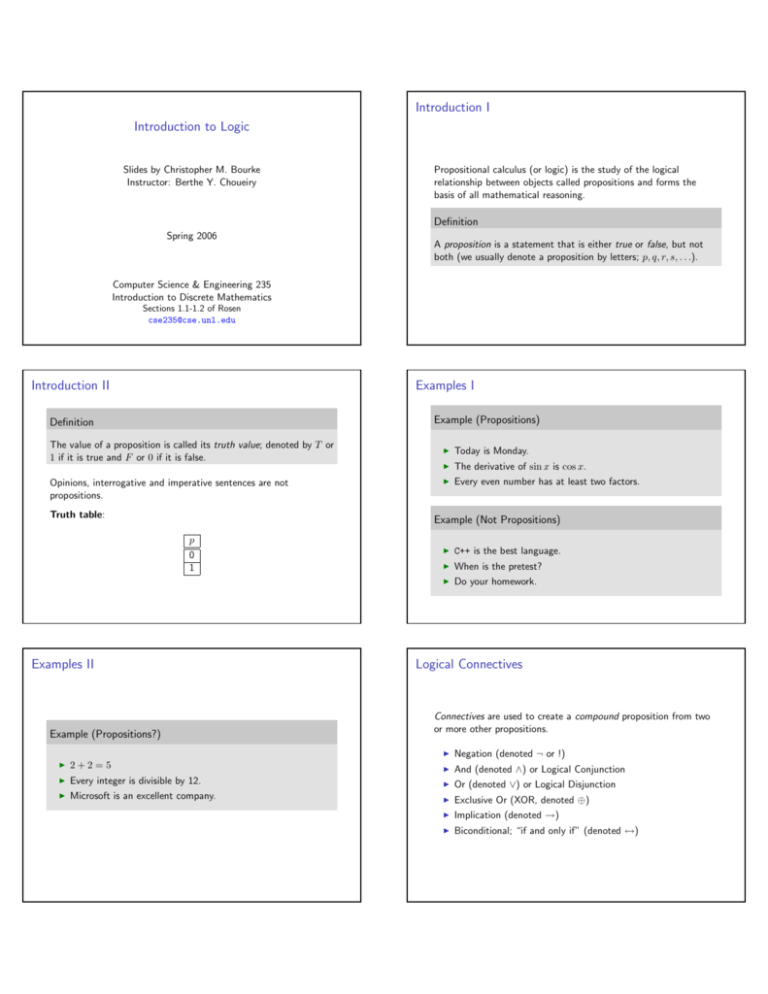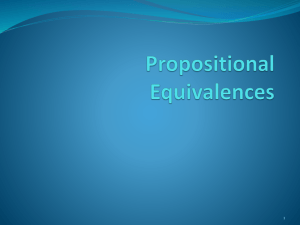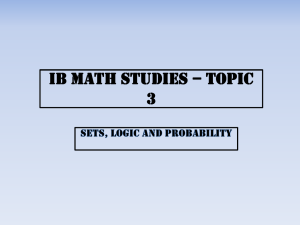Introduction to Logic Introduction I Introduction II Examples I
advertisement

Introduction I Introduction to Logic Slides by Christopher M. Bourke Instructor: Berthe Y. Choueiry Propositional calculus (or logic) is the study of the logical relationship between objects called propositions and forms the basis of all mathematical reasoning. Definition Spring 2006 A proposition is a statement that is either true or false, but not both (we usually denote a proposition by letters; p, q, r, s, . . .). Computer Science & Engineering 235 Introduction to Discrete Mathematics Sections 1.1-1.2 of Rosen cse235@cse.unl.edu Introduction II Examples I Example (Propositions) Definition The value of a proposition is called its truth value; denoted by T or 1 if it is true and F or 0 if it is false. Opinions, interrogative and imperative sentences are not propositions. Truth table: I Today is Monday. I The derivative of sin x is cos x. I Every even number has at least two factors. Example (Not Propositions) p 0 1 Examples II Example (Propositions?) I C++ is the best language. I When is the pretest? I Do your homework. Logical Connectives Connectives are used to create a compound proposition from two or more other propositions. I Negation (denoted ¬ or !) I 2+2=5 I And (denoted ∧) or Logical Conjunction I Every integer is divisible by 12. I Or (denoted ∨) or Logical Disjunction I Microsoft is an excellent company. I Exclusive Or (XOR, denoted ⊕) I Implication (denoted →) I Biconditional; “if and only if” (denoted ↔) Negation Logical And A proposition can be negated. This is also a proposition. We usually denote the negation of a proposition p by ¬p. The logical connective And is true only if both of the propositions are true. It is also referred to as a conjunction. Example (Logical Connective: And) Example (Negated Propositions) I It is raining and it is warm. √ (2 + 3 = 5) ∧ ( 2 < 2) I Schrödinger’s cat is dead and Schrödinger’s cat is not dead. I I Today is not Monday. I It is not the case that today is Monday. I It is not the case that the derivative of sin x is cos x. Truth table: Truth table: p 0 1 p 0 0 1 1 ¬p 1 0 Logical Or q 0 1 0 1 p∧q 0 0 0 1 Exclusive Or The logical disjunction (or logical or) is true if one or both of the propositions are true. The exclusive or of two propositions is true when exactly one of its propositions is true and the other one is false. Example (Logical Connective: Or) Example (Logical Connective: Exclusive Or) It is raining or it is the second day of lecture. √ (2 + 2 = 5) ∨ ( 2 < 2) I The circuit is either is on or off. I I Let ab < 0, then either a < 0 or b < 0 but not both. I You may have cake or ice cream.1 I You may have cake or ice cream, but not both. I Truth table: Truth table: p 0 0 1 1 1 q 0 1 0 1 p∧q 0 0 0 1 p∨q 0 1 1 1 p 0 0 1 1 q 0 1 0 1 p⊕q 0 1 1 0 Can I have both? Implications I Implications II Definition The implication p → q can be equivalently read as Let p and q be propositions. The implication p→q is the proposition that is false when p is true and q is false and true otherwise. Here, p is called the “hypothesis” (or “antecedent” or “premise”) and q is called the “conclusion” or “consequence”. Truth table: p 0 0 1 1 q 0 1 0 1 p→q 1 1 0 1 I if p then q I p implies q I if p, q I p only if q I q if p I q when p I q whenever p I p is a sufficient condition for q (p is sufficient for q) I q is a necessary condition for p (q is necessary for p) I q follows from p Examples Exercise Which of the following implications is true? Example I If you buy your air ticket in advance, it is cheaper. I If 2 + 2 = 5 then all unicorns are pink. I If x is a real number, then x2 ≥ 0. I If it rains, the grass gets wet. I If the sprinklers operate, the grass gets wet. Biconditional I If −1 is a positive number, then 2 + 2 = 5. true: the hypothesis is obviously false, thus no matter what the conclusion, the implication holds. I If −1 is a positive number, then 2 + 2 = 4. true: for the same reason as above I If sin x = 0 then x = 0. false: x can be any multiple of π; i.e. if we let x = 2π then clearly sin x = 0, but x 6= 0. The implication “if sin x = 0 then x = kπ for some integer k” is true. Examples Definition p ↔ q can be equivalently read as The biconditional p↔q is the proposition that is true when p and q have the same truth values. It is false otherwise. I p if and only if q I p is necessary and sufficient for q I if p then q, and conversely I p iff q (Note typo in textbook, page 9, line 3.) Note that it is equivalent to (p → q) ∧ (q → p) Example Truth table: p 0 0 1 1 q 0 1 0 1 p→q 1 1 0 1 q→p 1 0 1 1 p↔q 1 0 0 1 I x > 0 if and only if x2 is positive. I The alarm goes off iff a burglar breaks in. I You may have pudding if and only if you eat your meat.1 1 Exercise How can you have any pudding if you don’t eat your meat? Converse, Contrapositive, Inverse Which of the following biconditionals is true? I I I x2 + y 2 = 0 if and only if x = 0 and y = 0 true: both implications hold. √ 2 + 2 = 4 if and only if 2 < 2 true: for the same reason above. x2 ≥ 0 if and only if x ≥ 0. false: The converse holds. That is, “if x ≥ 0 then x2 ≥ 0”. However, the implication is false; consider x = −1. Then the hypothesis is true, 12 ≥ 0 but the conclusion fails. Consider the proposition p → q: I Its converse is the proposistion q → p. I Its inverse is the proposistion ¬p → ¬q. I Its contrapositive is the proposistion ¬q → ¬p. Truth Tables I Constructing Truth Tables Truth Tables are used to show the relationship between the truth values of individual propositions and the compound propositions based on them. Construct the Truth Table for the following compound proposition. ((p ∧ q) ∨ ¬q) p 0 0 1 1 q 0 1 0 1 p∧q 0 0 0 1 p∨q 0 1 1 1 p⊕q 0 1 1 0 p→q 1 1 0 1 p↔q 1 0 0 1 p 0 0 1 1 Table: Truth Table for Logical Conjunction, Disjunction, Exclusive Or, and Implication Precedence of Logical Operators q 0 1 0 1 p∧q 0 0 0 1 ¬q 1 0 1 0 ((p ∧ q) ∨ ¬q) 1 0 1 1 Usefulness of Logic Just as in arithmetic, an ordering must be imposed on the use of logical operators in compound propositions. Logic is more precise than natural language: Of course, parentheses can be used to make operators disambiguous: ¬p ∨ q ∧ ¬r ≡ (¬p) ∨ q ∧ (¬r) But to avoid using unnecessary parentheses, we define the following precedences: I You may have cake or ice cream. Can I have both? I If you buy your air ticket in advance, it is cheaper. Are there or not cheap last-minute tickets? For this reason, logic is used for hardware and software specification. 1. (¬) Negation Given a set of logic statements, one can decide whether or not they are satisfiable (i.e., consistent), although this is a costly process... 2. (∧) Conjunction 3. (∨) Disjunction 4. (→) Implication 5. (↔) Biconditional Bitwise Operations Logic in Theorerical Computer Science Computers represent information as bits (binary digits). SAT A bit string is a sequence of bits, the length of the string is the number of bits in the string. Logical connectives can be applied to bit strings (of equal length). To do this, we simply apply the connective rules to each bit of the string: What is SAT? SAT is the problem of determining whether or not a sentence in propositional logic (PL) is satisfiable. Characterizing SAT as an NP-complete problem is at the foundation of Theoretical Computer Science. Example Defining SAT 0110 0101 0111 0100 0011 1010 0010 1010 0010 1000 1101 1111 1111 1101 0010 bitwise Or bitwise And bitwise Xor A Boolean variable is a variable that can have value 0 or 1. I Given: a PL sentence. I Question: Determine whether it is satisfiable or not. What is a PL sentence? What does satisfiable mean? Logic in Theorerical Computer Science Logic in Programming A sentence in PL Programming Example I I A sentence in PL is a conjunction of clauses I A clause is a disjunction of literals Say you need to define a conditional statement as follows: “Increment x if all of the following conditions hold: x > 0, x < 10 and x = 10.” I A literal is a term or its negation You may try: I A term is a (Boolean) variable (or proposition) Example: (a ∨ b ∨ ¬c ∨ ¬d) ∧ (¬b ∨ c) ∧ (¬a ∨ c ∨ d) A sentence in PL is a satisfiable iff we can assign truth value to the Boolean variables such that the sentence evaluates to true (i.e., holds). if(0<x<10 OR x=10) x++; But is not valid in C++ or Java. How can you modify this statement by using a logical equivalence? Answer: if(x>0 AND x<=10) x++; Logic In Programming Propositional Equivalences Programming Example II Introduction Say we have the following loop: while ((i<size AND A[i]>10) OR (i<size AND A[i]<0) OR (i<size AND (NOT (A[i]!= 0 AND NOT (A[i]>= 10))))) To manipulate a set of statements (here, logical propositions) for the sake mathematical argumentation, an important step is to replace one statement with another equivalent statement (i.e., with the same truth value). Below, we discuss: Is this good code? Keep in mind: I Readability. I Extraneous code is inefficient and poor style. I Complicated code is more prone to errors and difficult to debug. I Terminology I Establising logical equivalences using truth tables I Establising logical equivalences using known laws (of logical equivalences) Solution? Terminology Logical Equivalences Tautologies, Contradictions, Contingencies Definition Definition I A compound proposition that is always true, no matter what the truth values of the propositions that occur in it is called a tautology. I A compound proposition that is always false is called a contradiction. I Finally, a proposition that is neither a tautology nor a contradiction is called a contingency. Definition Propositions p and q are logically equivalent if p ↔ q is a tautology. Informally, p and q are logically equivalent if whenever p is true, q is true, and vice versa. Notation p ≡ q (“p is equivalent to q”), p ⇐⇒ q, p ⇔ q, p ↔ q. Example A simple tautology is p ∨ ¬p A simple contradiction is p ∧ ¬p Alort: ≡ is not a logical connective. Example Another Example Are and p → q and ¬p ∨ q logically equivalent? (Exercise 23 from Rosen): Show that To find out, we construct the truth tables for each: p 0 0 1 1 p→q 1 1 0 1 q 0 1 0 1 ¬p 1 1 0 0 (p → r) ∨ (q → r) ≡ (p ∧ q) → r ¬p ∨ q 1 1 0 1 p 0 0 0 0 1 1 1 1 The two columns in the truth table are identical, thus we conclude that p → q ≡ ¬p ∨ q q 0 0 1 1 0 0 1 1 r 0 1 0 1 0 1 0 1 p→r 1 1 1 1 0 1 0 1 Another Example Logical Equivalences Continued Cheat Sheet (q → r) 1 1 0 1 1 1 0 1 (p → r) ∨ (q → r) 1 1 1 1 1 1 0 1 Now let’s do it for (p ∧ q) → r: p 0 0 0 0 1 1 1 1 q 0 0 1 1 0 0 1 1 r 0 1 0 1 0 1 0 1 p∧q 0 0 0 0 0 0 1 1 (p ∧ q) → r 1 1 1 1 1 1 0 1 Tables of logical equivalences can be found in Rosen (page 24). These and other can be found in a handout on the course web page http://www.cse.unl.edu/~cse235/files/ LogicalEquivalences.pdf Let’s take a quick look at this Cheat Sheet The truth values are identical, so we conclude that the logical equivalence holds. Using Logical Equivalences Using Logical Equivalences Example 1 Example 2 Example (Exercise 27)1 : Show that Logical equivalences can be used to construct additional logical equivalences. Example: Show that (p ∧ q) → q is a tautology ((p ∧ q) → q) ⇐⇒ ⇐⇒ ⇐⇒ ⇐⇒ ⇐⇒ ¬(p ∧ q) ∨ q (¬p ∨ ¬q) ∨ q ¬p ∨ (¬q ∨ q) ¬p ∨ 1 1 ¬(p ↔ q) ⇐⇒ (p ↔ ¬q) Sometimes it helps to start out with the second proposition. (p ↔ ¬q) ⇐⇒ ⇐⇒ ⇐⇒ ⇐⇒ ⇐⇒ ⇐⇒ ⇐⇒ Implication Law De Morgan’s Law (1st) Associative Law Negation Law Domination Law 1 (p → ¬q) ∧ (¬q → p) (¬p ∨ ¬q) ∧ (q ∨ p) ¬ (¬ ((¬p ∨ ¬q) ∧ (q ∨ p))) ¬ (¬(¬p ∨ ¬q) ∨ ¬(q ∨ p)) ¬ ((p ∧ q) ∨ (¬q ∧ ¬p)) ¬ ((p ∧ q) ∨ (¬p ∧ ¬q)) ¬(p ↔ q) Equivalence Law Implication Law Double Negation De Morgan’s Law De Morgan’s Law Commutative Law Equivalence Law (See Table 7, p24) This appears in Table 7, but you are not allowed to use it to prove it. Using Logical Equivalences Logic In Programming Example 3 Programming Example II Revisited Show that ¬(q → p) ∨ (p ∧ q) ⇐⇒ q Recall the loop: ¬(q → p) ∨ (p ∧ q) ⇐⇒ ⇐⇒ ⇐⇒ ⇐⇒ ⇐⇒ ⇐⇒ (¬(¬q ∨ p)) ∨ (p ∧ q) (q ∧ ¬p) ∨ (p ∧ q) (q ∧ ¬p) ∨ (q ∧ p) q ∧ (¬p ∨ p) q∧1 q Implication Law De Morgan’s & Double Negation Commutative Law Distributive Law Cancelation Law Identity Law Logic In Programming while((i<size AND A[i]>10) OR (i<size AND A[i]<0) OR (i<size AND (NOT (A[i]!= 0 AND NOT (A[i]>= 10))))) Now, using logical equivalences, simplify it. Programming Pitfall Note Programming Example II Revisited Answer: Use De Morgan’s Law and Distributivity. while((i<size) AND ((A[i]>10 OR A[i]<0) OR (A[i]==0 OR A[i]>=10))) In C, C++ and Java, applying the commutative law is not such a good idea. These languages (compiler dependent) sometimes use “short-circuiting” for efficiency (at the machine level). For example, consider accessing an integer array A of size n. if(i<n && A[i]==0) i++; Notice the ranges of all four conditions on A[i]; they can be merged and we can further simplify it to: is not equivalent to if(A[i]==0 && i<n) i++; while((i<size) AND (A[i]>=10 OR A[i]<=0))










